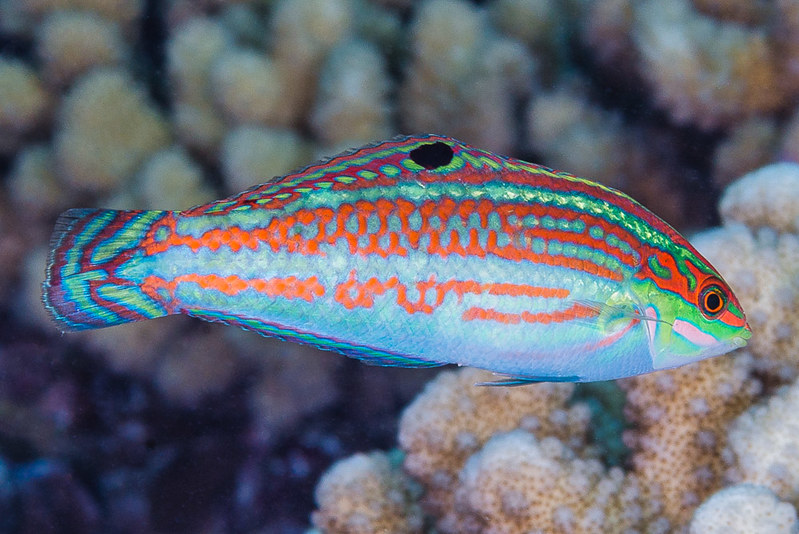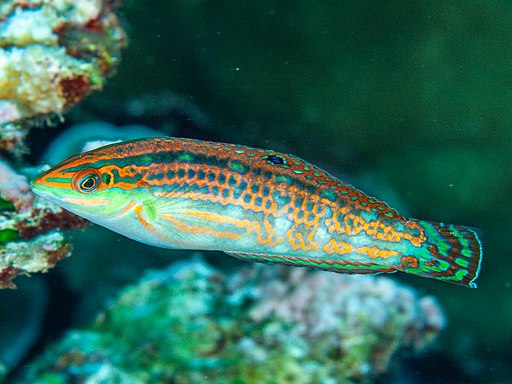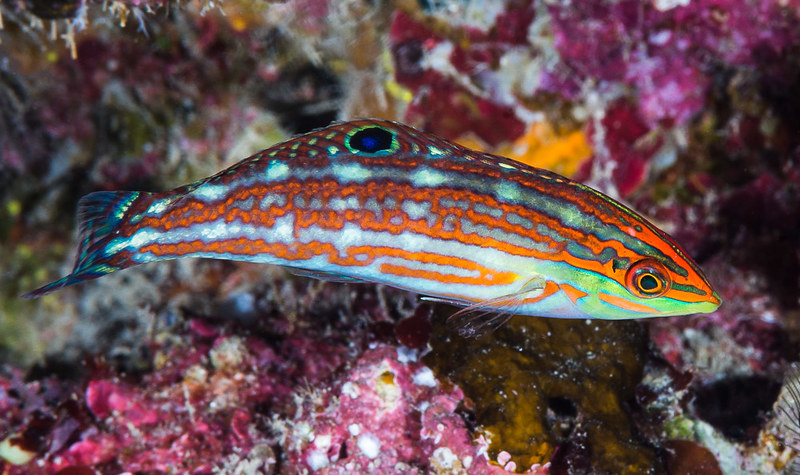Christmas Wrasse: Care, Size, Appearance & More
Posted by on 2/19/2023
We use affiliate links and may receive a small commission on purchases.
Hobbyists looking for a peaceful, vibrant fish should look no further than the Christmas Wrasse. This species showcases beautiful color patterns, with a predominantly red, green, and blue coloration.
Wrasse fish are known for being low-maintenance, but hobbyists need to keep in mind that they do have unique care requirements. If you're considering this fish as a new addition to your saltwater aquarium, it's your responsibility to provide it with the highest level of care. In this post, we'll discuss everything you'll need to know if you plan on purchasing this exciting species.
Table of Contents
January's Giveaways on Light Fish
Species Summary
The Christmas Wrasse (scientific name: Halichoeres claudia) is an undemanding species from the Labridae family . This sexually dichromatic fish hails from the southwestern Pacific, where it can be found swimming at depths of up to 20 meters near the Great Barrier Reef, French Polynesia, and Christmas Island .
The scientific name is a tribute to Claudia Rocha, the wife of Ichthyologist Luiz Rocha , and earned its classification as recently as 2009. There is some debate as to where the species received its common name. Some hobbyists argue the fish is named after its holiday-like coloration, while others associate their name with the fish's origins near Christmas Island . To make things a bit more confusing, many hobbyists consider any Halichoeres Wrasse that showcases bright reds, blues, and greens to be a Christmas Wrasse (such as Halichoeres ornatissimus) and a wrasse from another Genus, Thalassoma trilobatum, is also referred to as a Christmas Wrasse! However, Thalassoma trilobatumthis is a much larger fish and is rarely seen in the aquarium hobby.

Appearance
The Christmas Wrasse sports a slender, torpedo-shaped body, covered in horizontal red and orange lines that extend into the dorsal, caudal, and anal fins. The fish's black eye is surrounded by a red and subsequent green ring, and translucent pectoral fins aid in keeping the fish afloat.
A small mouth allows the fish to feed off small crustaceans to fuel its carnivorous diet.

Male vs Female
Hobbyists looking to distinguish between males and females should look towards the black dots, known as ocelli that exist on the dorsal fins.
Males should have no ocelli on the dorsal fins, while females will have between 1-2 ocelli. The Christmas Wrasse, similar to other Halichoeres species, will change sex to male in captivity.
Size
The Christmas Wrasse is a small fish, with adult versions maxing out at about 5 inches in length.
As with all aquarium fish, providing the Christmas Wrasse with a nutrient-rich diet, a safe environment with no aggressive tank mates, and plenty of room to swim will aid in the fish reaching its full adult size.
Halichoeres claudia vs Thalassoma trilobatum
Hobbyists looking to distinguish the differences between these two species which share the same common name should examine their sizes. Halichoeres claudia is much smaller, only about 5 inches in length.
Thalassoma trilobatum is extremely large, growing to about 1 foot in length. This species requires a massive aquarium, over 260 gallons in size. While it's extremely rare to see the species in a home aquarium, it does make appearances in community aquariums and scientific displays.

Christmas Wrasse Care
Caring for the Christmas Wrasse is relatively easy compared to other saltwater fish species. Their peaceful temperament and small size open up plenty of interesting opportunities for tank mates and nano aquariums, but species of wrasse, including the Christmas wrasse, do have some personality traits you'll need to be aware of.
To achieve success with care, you'll want to re-create their native environment as closely as possible.
Lifespan
The Christmas Wrasse, similar to other Halichoeres species, can live for about 8 years in captivity.
Providing a well-balanced diet and a stress-free environment will allow them to develop strong immune systems, which can aid in preventing life-ending infections and parasites.
Tank Size
Hobbyists looking to purchase a Christmas Wrasse should have an aquarium that's at least 50 gallons in size.
The Christmas Wrasse makes an excellent candidate for Nano-sized aquariums , but these fish are also capable of existing comfortably in much larger tanks. If budget allows, the larger the tank - the easier to maintain, as larger tanks tend to be more stable and experience chemistry swings less suddenly compared to nano aquariums.

Acclimation
Hobbyists should exercise the same acclimation procedures that they follow for any other saltwater fish. You'll need to introduce the Christmas Wrasse into an established quarantine tank, where you can examine the species over a 3-4 week period.
Assuming your Christmas Wrasse is in good health, you can transfer the species to an acclimation box , where they can adjust to your display tank conditions over a 2-3 day period. You can directly feed them using a pipette during this time, after which they can be released into the remainder of the display tank.
Water Conditions
In the wild, the Christmas Wrasse lives in a tropical environment, where warm, sunlit waters contain an abundance of aquatic life. You'll need to closely mimic the water chemistry in these regions of the world so that your Christmas Wrasse can live comfortably.
The following parameters should be recreated and maintained:
Specific Gravity: 1.020-1.025
Temperature Range: 72°F-78°F
KH: 8-12 dKH
pH: 8.1-8.4
Ammonia: 0ppm
Nitrite: < .2ppm
Nitrate: 5-10ppm
Although the Christmas Wrasse is considered a hardy fish, you'll still want to monitor your water chemistry with a reliable testing kit to ensure their safety.
Tank Setup
It's important to properly plan your aquarium setup before purchasing a Christmas Wrasse. Since these fish, similar to other species of Wrasses, tend to jump, a tight-fitting lid is an essential purchase.
You'll also need to provide a sandbed, with 2-4m granules that are at least 1 inch in depth. The Christmas Wrasse is a member of the Halichoeres genus, and as such, they will bury at night or when threatened.
Moderate to high flow is recommended for the species, as they'll appreciate a steady current to test their swimming abilities. Plenty of live rock should be provided, but it's important to reserve plenty of open space for swimming.
Common Diseases
Wrasses, including the Christmas Wrasse, have a thick slime coat that allows the fish to be more resistant to common illnesses, such as marine velvet and ich. While they aren't completely immune, it's important to properly acclimate them before introducing them into a display tank.
Intestinal parasites, such as Flukes, can affect the Christmas Wrasse, symptoms typically include mucus around the gills, lethargy, loss of appetite, and flashing. Treatment involves Prazi-Pro or Praziquantel, hyposalinity, and Formalin dips. The affected fish should be closely monitored for a 1-2 month period until it no longer displays symptoms.
While very few aquarists want to deal with diseases, preventing them from occurring in the first place is the best form of treatment. Always continuously monitor the conditions of your tank and quarantine any new inhabitants before introducing them into your display tank.
Food & Diet
The Christmas Wrasse should be fed a diet consisting of prepared foods, such as Brine shrimp, Mysis shrimp, copepods, and nutrient-rich pellet food 1-2 times a day.
Christmas Wrasses have a short digestive tract, and a reputation for being excellent scavengers, consuming pests such as flatworms and bristleworms.
Reef Compatibility
The Christmas Wrasse is reef safe, opening up plenty of unique coral options such as leather corals, torches, candy canes, and blastos.
However, hobbyists who also house invertebrates such as pistol shrimp should proceed with caution. The Christmas Wrasse is a carnivorous fish and will pick at and consume smaller invertebrates. In most cases, the scenario can be mitigated by staying on top of regular feedings.
Behavior and Temperament
The Christmas Wrasse is a peaceful, active, and inquisitive fish making it a joy to observe in a saltwater aquarium. It's not nearly as shy as more timid wrasses, such as the pink streaked wrasse, and can often be seen investigating live rock and small crevices for new food sources.
They tend to swim around the bottom and middle of the water column, which isn't surprising considering they tend to swim well beneath the ocean's surface in the wild.
When first introduced to an aquarium, they may exhibit shy behavior and hide out in the sandbed. Typically they'll be more confident in about a week after they've been introduced into your display tank.
Tank Mates
The Christmas Wrasse's peaceful temperament might be its greatest appeal, as hobbyists can pair the fish with a variety of different species provided a large enough aquarium.
Some suitable tank mate options include:
-
Blonde Naso Tang (requires a 180-gallon aquarium)
The Christmas Wrasse can also co-exist quite comfortably with other Halichoeres species when properly acclimated, such as the Yellow Coris Wrasse and the solo member of the Pseudocheilinops genus, the Pink-Streaked Wrasse.
Avoid aggressive species, such as the Tessalata Eel, Blue Toby Puffer, and other Christmas Wrasses, as this can result in territorial disputes. You'll want to consider avoiding invertebrates such as Pistol Shrimp or anemones such as the Black Widow, as the Christmas Wrasse has an appetite for inverts.
Breeding
Although the similar-looking Ornate Wrasse (scientific name: Halichoeres ornatissimus) has been successfully bred in captivity , we've yet to see the Christmas Wrasse achieve a captive-bred designation.
Fortunately, the species is common and widely available and has a Least Concern designation by the IUCN.
Where To Purchase
The Christmas Wrasse can be found on our marketplace and can occasionally be found at local fish stores and large online vendors. Although certain species of wrasses can go for exorbitantly high prices, the Christmas Wrasse is relatively affordable, often going for $30-60 in the United States.
In Conclusion
The Christmas Wrasse is an excellent choice for hobbyists looking for pest control or for those looking to add another peaceful species to their saltwater aquarium. Its reef compatibility makes a great choice for hobbyists eager to fill an aquarium with coral, or for those who want to pair the wrasse with different types of wrasses.
Now that we've covered the fundamentals, do you plan on adding one to your saltwater aquarium? Let us know your thoughts by commenting below, and be sure to check out our community forum and marketplace.
January's Giveaways on Light Fish


